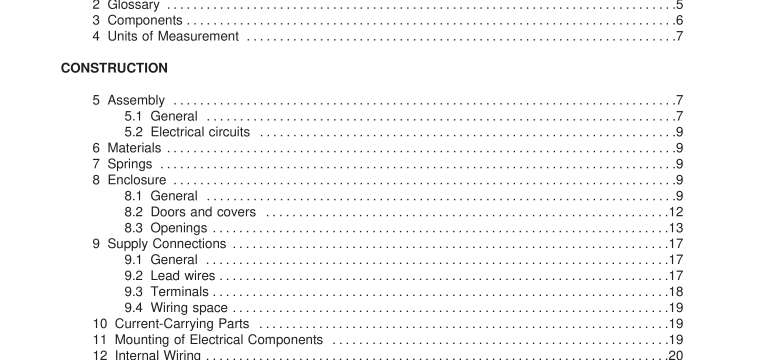UL 17-2008 pdf download.Vent or Chimney Connector Dampers for Oil-Fired Appliances.
5 Assembly 5.1 General 5.1 .1 A vent or chimney connector damper shall be constructed and assembled so that it will: a) Withstand a flue gas temperature of at least 538°C (1 000°F), and b) Have the strength and rigidity necessary to resist the abuses to which it may be subjected, without total or partial collapse or without reduction of spacings, loosening or displacement of parts, or other serious defects, when it is tested in accordance with the requirements of this standard. Exception: A vent or chimney connector damper may be intended for a flue gas temperature less than 538°C but not less than 399°C (750°F) provided the assembly is marked in accordance with 33.1 (d). 5.1 .2 A joint in metal surfaces of a flue gas passageway shall be tight, as attained by being welded, lock-seamed, riveted, or bolted. 5.1 .3 If a vent or chimney connector damper consists of two or more subassemblies that are to be joined in the application to form one assembly, each subassembly shall be constructed for ready attachment of one to the other without requiring alteration, drilling, welding or cutting or a similar task by the installer. The securement of subassemblies to each other shall be by use of conventional means such as screws or bolts and such securement means shall be provided as part of the subassemblies. 5.1 .4 With respect to 5.1 .3, the subassemblies that must bear a definite relationship to each other in order to operate as intended shall be arranged and constructed so as to permit them to be assembled only in the correct relationship with each other. 5.1 .5 All operating parts of a vent or chimney connector assembly shall be secured against displacement and shall be constructed so as to maintain a fixed relationship between the parts under intended conditions of operation and handling.
5.1 .7 To comply with the requirement in 5.1 .6, the vent or chimney connector damper shall include a time-delay feature that delays the closing of the damper blade so that it does not attain a fully closed position until a minimum of 3 minutes after the burner shutdown. Exception No. 1 : Less than 3 minutes time-delay may be provided if the vent or chimney connector damper assembly is tested as described in 21 .1 – 21 .3. Exception No. 2: No time-delay is required if the damper blade provides, in the fully closed position, some free venting area and the vent or chimney connector damper assembly is tested as described in 21 .1 – 21 .3. 5.1 .8 A vent or chimney connector damper assembly shall interlock electrically with the oil burner primary safety control so that the burner can be fired only if the damper blade is in a fully open position. 5.1 .9 A vent or chimney connector damper assembly intended for use with an oil-fired appliance that includes a constant burning gas pilot shall provide an internal free venting area of the vent gas passageway of not less than 5 percent of the total outlet free venting area. 5.1 .1 0 The inlet and outlet connections of a vent or chimney connector damper assembly shall be of the same nominal size and shall accommodate commercially available flue pipe sizes of integral inch diameter such as 4, 5, 6, 7, 8, 9, 1 0, and 1 2. 5.1 .1 1 The inlet and outlet connections shall each provide at least a 1 -1 /4 inch (31 .7 mm) insertion depth (lip) for the attachment of the vent or chimney connector pipe.
5.1 .1 2 The vent or chimney connector vent damper assembly shall be constructed so that, with the damper blade in its intended fully open position, the internal free venting area of the vent or chimney connector on which the assembly is intended to be installed is not reduced by more than 5 percent. 5.1 .1 3 The vent or chimney connector vent damper assembly shall include an indicator that is visible during operation of the vent damper to signify the position of the damper blade. 5.1 .1 4 A pilot or signal light that is used to indicate the damper blade position shall be arranged so that impaired operation of the light (such as a burned out bulb) would not signify an open damper blade position.UL 17-2008 pdf download.
UL 17-2008 pdf download
